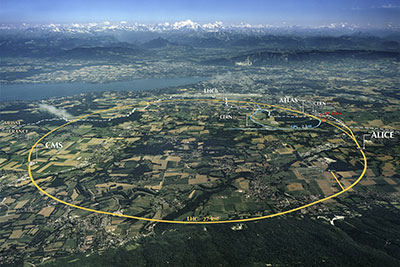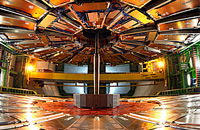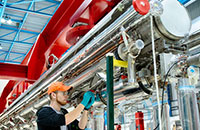LHC, LCLS-II and future accelerators

Fermilab is actively involved in the research and development of future particle accelerators around the world, contributing to the next generation of machines. These accelerators, each with its own specialty, would open new windows into our universe, allowing us to view it from as yet unexplored vantages.
Upgrades to the Large Hadron Collider

Through its participation in the LHC Accelerator Research Program, called US LARP, Fermilab contributes to the upgrade of CERN's Large Hadron Collider, the largest and highest-energy particle collider in the world. To extend its reach, scientists and engineers are designing upgrades to the LHC. One of the possible outcomes of these upgrades is a future High-Luminosity LHC.
To extend its discovery potential, the LHC will need a major upgrade around 2020 to increase its luminosity, or collision rate, by a factor of 10 beyond its design value. Such an upgrade of the LHC requires careful study and about 10 years to implement.
In July 2012, experimenters at the LHC announced the discovery of the Higgs boson, the last major missing piece of the Standard Model of particle physics. A more powerful LHC would provide more accurate measurements of new particles and enable observation of rare processes that occur below the current sensitivity level. This would make it possible to detect rare events not previously witnessed and increase our understanding of the Energy Frontier.
The novel machine configuration, called the High-Luminosity LHC, will rely on a number of key innovative technologies, representing exceptional technological challenges. Fermilab will make major contributions to the HL-LHC through the advances that have been developed in accelerator and magnet technology.
Learn more about US LARP.
Learn more about the High-Luminosity LHC.
LCLS-II

Fermilab is one of the partner institutions contributing to SLAC National Accelerator Laboratory's Linac Coherent Light Source II (LCLS-II), an electron accelerator project that will produce a high-power free-electron laser for cutting-edge scientific explorations ranging from refined observations of molecules and cellular interactions to innovative materials engineering. Argonne National Laboratory, Cornell University, Lawrence Berkeley National Laboratory and Thomas Jefferson National Accelerator Facility are also partners.
Fermilab is contributing to LCLS-II in the overlapping areas of superconducting radio-frequency accelerator technology and cryogenics, critical components that distinguish LCLS-II from SLAC's current LCLS facility, whose laser production has enabled noted scientific investigations in cancer treatment and other important areas.
Learn more about Fermilab's contributions to LCLS-II.
Learn more about the LCLS-II at SLAC.
A Future Circular Collider at CERN
At 80 to 100 kilometers in circumference, a proposed future collider at CERN is a giant, even compared to the Large Hadron Collider. It would allow scientists to study the Higgs boson and physics at the electroweak scale at unprecedented precision, delivering proton beams that would achieve 100 TeV at the center of mass – 12 times higher energy than recently available at the LHC. Fermilab scientists are among the hundreds of collaborators on this ambitious project.
Learn more about a Future Circular Collider at CERN.
- Last modified
- 07/28/2016
- email Fermilab

